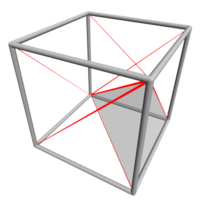Marching tetrahedra

Marching tetrahedra is like playing a game of connect the dots, but these dots are actually little triangles called tetrahedrons. Imagine you have a picture of a mountain range made up of lots of tiny triangles. Now, if you want to know where the hill slopes down or where the valleys are, you need to figure out the shape of these triangles in 3D space.
This is where marching tetrahedra comes into play. It helps you figure out the shape of any object that can be represented as a bunch of triangles in space. So, you start by taking a cube and dividing it into eight smaller cubes. Then, you look at each of these smaller cubes and decide whether each corner of that cube is inside the object you're trying to represent or outside. You can do this by using some fancy math tricks.
Once you know which corners are inside the object and which ones are outside, you can use the tetrahedrons to connect the inside corners with each other and the outside corners with each other. These little tetrahedrons form a kind of mesh that represents the shape of your object.
Now, you can use this mesh to do all kinds of things, like figuring out how light would reflect off of the object, or how it would look from different angles. It's all because of the marching tetrahedra algorithm that helps us figure out the shape of any triangle-shaped object in space.
This is where marching tetrahedra comes into play. It helps you figure out the shape of any object that can be represented as a bunch of triangles in space. So, you start by taking a cube and dividing it into eight smaller cubes. Then, you look at each of these smaller cubes and decide whether each corner of that cube is inside the object you're trying to represent or outside. You can do this by using some fancy math tricks.
Once you know which corners are inside the object and which ones are outside, you can use the tetrahedrons to connect the inside corners with each other and the outside corners with each other. These little tetrahedrons form a kind of mesh that represents the shape of your object.
Now, you can use this mesh to do all kinds of things, like figuring out how light would reflect off of the object, or how it would look from different angles. It's all because of the marching tetrahedra algorithm that helps us figure out the shape of any triangle-shaped object in space.
Related topics others have asked about:
